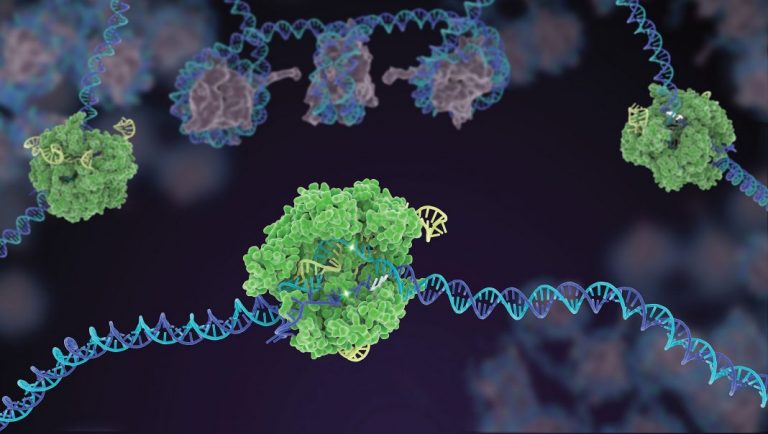
A new base-editing system that uses RNA aptamers to position DNA modifying enzymes at genome targets is adept in performing point-mutation edits and can enhance the therapeutic potential of genome editing, reported a new study in The CRISPR Journal.
“The fundamental differences between the Pin-point system and existing system is in the recruitment,” said Shengkan Jin, PhD, associate professor at the department of pharmacology, Rutgers University. “In our technology, the recruitment of the DNA deaminase effector is done by RNA aptamers, which are part of the guide RNA.” In conventional base editing systems, the effector enzyme is fused to an inactive Cas9 molecule.
The development and design of this modular base editing system, which has been licensed to Horizon Discovery (now part of PerkinElmer) by Rutgers University, is described in the new article, “Development and Characterization of a Modular CRISPR and RNA Aptamer Mediated Base Editing System,” published in The CRISPR Journal (published by Clinical OMICs’ publisher, Mary Ann Liebert Inc.).
The use of RNA aptamers to separate the DNA-recognition module from the DNA-modifying module has its advantages. “You can now combine a single Cas9 with different effectors just by modifying the guide RNA, without having to make a different fusion protein. The modular approach makes this system very flexible,” Jin told GEN, sister publication to Clinical OMICs.
There already exists a large repertoire of Cas9s, effectors, and guide RNAs with different efficiencies and properties at different classes of mutations. For the best therapeutic outcome, it may be necessary to mix and match components of the base editing system. “Our modular system makes this mix-and-match easy for the best outcome,” Jin said. “We can now easily multiplex—for example, using the same Cas9 with different effectors, you can simultaneously change an A [adenine] in gene X and a C [cytosine] in gene Y.”
Multiplexing is useful both for ex vivo therapeutic applications such as in CAR-T cell development and in in vivo therapeutic development.
“The second advantage is the reduced size of the transcript payload,” said Jin. “In our system, the effector is not part of the CRISPR protein. So, the transcript is much smaller and more compatible with AAV [adeno-associated virus] delivery. AAV can only accommodate a maximum transcript size of 4.3 kb. Cas9 is already a large protein. Fusing it with an effector exceeds the payload of the delivery system. The significantly smaller size of our system makes it compatible with in vivo therapeutic delivery.”
In the current report, the Jin group, led by Juan Carlos Collantes, PhD, postdoctoral researcher, working in collaboration with researchers from Horizon, showed that the Pin-point system can achieve targeted base modification with high precision in bacteria and in human cell lines. In bacteria, the Rutgers team tested the system through targeting a gene responsible for imparting resistance to the antibiotic rifampicin. When the rifampicin resistance determining gene was base edited using the Pin-point system, survival of bacteria in the presence of the antibiotic increased compared to unaltered bacteria.
Collantes and coworkers also corrected loss-of-function mutations in the human genome. The Pin-point system restored fluorescence in HEK293T cells with a mutated non-fluorescent EGFP gene (conversion to the normal sequence was confirmed using next-generation sequencing). The authors also found that bystander mutations close to the target site were low while exome-wide sequence analysis showed no detectable off-target effects.
“Pin-point can be used to correct a single mutated base pair just like the existing system. It can also easily generate a nonsense mutation in a gene to permanently knockout a disease-causing gene. The system can also be used to skip an exon by mutating a single base in the splice site—for instance, in cases where many disease-causing mutations are concentrated in a single exon and it is not possible correct them individually,” said Jin.
“Since taking on this original design in the early part of 2019, we have further developed Pin-point internally, both in terms of technical optimization or editing versatility and reagent format or delivery, as well as driving the development of Pin-point for potential therapeutic application with a particular focus on engineered CAR-T cell therapy,” said Jennifer Harbottle, PhD, senior scientist in the R&D base editing team of PerkinElmer’s Horizon Discovery business, and a co-author of The CRISPR Journal paper.
Jin confirmed to GEN that there are promising therapeutic possibilities for this technology that has been licensed to Horizon/PerkinElmer. “Initially Horizon focused on ex vivo therapies using the technology but now after the merger, they will have more resources to develop animals and human therapeutics.”
The publicly traded Beam Therapeutics—co-founded by genome editing pioneers David Liu, Ph.D., J. Keith Joung, M.D., and Feng Zhang, Ph.D.—is currently the front-runner in the development of therapeutics developed using base editing, building on key papers published by Liu’s lab in 2016–17.
Commenting on whether this new technology can compete with Beam, Jin said: “The answer is yes. But of course, each will have its own characteristics, benefits, and accessibility. Our platform has unique features. Both systems are good. [Horizon/PerkinElmer] will develop its own uses of the technology. It is always good to have multiple competing technologies in the market. Different companies can get access to what they want and then generate the best versions for therapeutic benefits.”
Jin continued: “One reason why we chose Horizon/PerkinElmer is because they are very open to sub-license the technology out to individual pharma companies to further co-develop the platform and therapeutics.”













